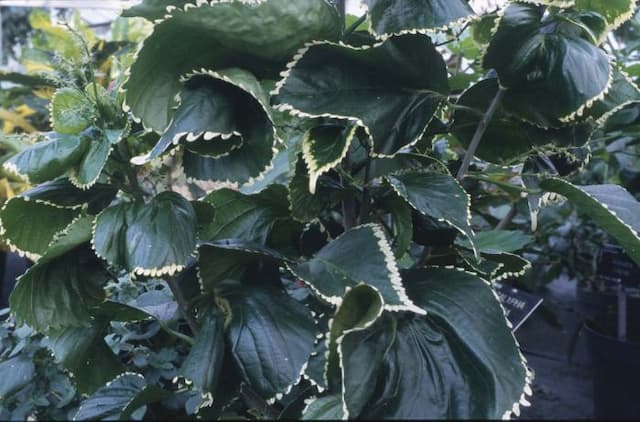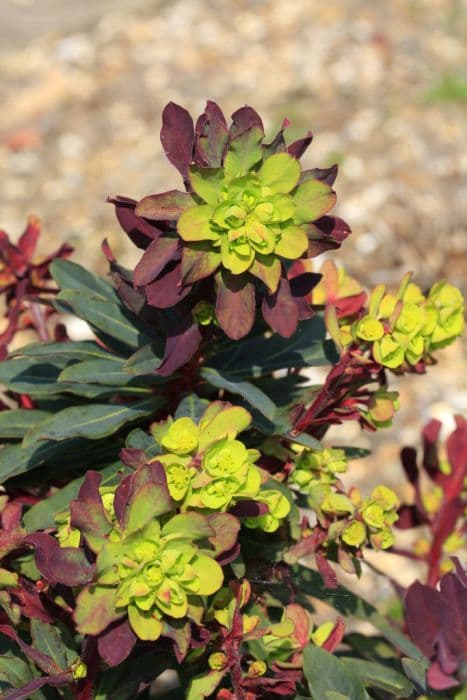Martin's Spurge Euphorbia × martini 'Helen Robinson'

ABOUT
Euphorbia × martini 'Helen Robinson' is characterized by a striking combination of foliage and flowers. Its leaves are slender and elongated, sporting a fresh green color which remains vibrant throughout the growing season. The plant's most distinctive feature is its flowers, which are not true flowers in the conventional sense but are bracts – modified leaves – that surround the tiny, more inconspicuous flowers. These bracts are typically a radiant chartreuse to yellow-green color, offering a contrast that makes the blooms stand out brilliantly against the foliage. As the seasons change, hints of pink or red may appear on the bracts or foliage, adding to the plant's visual appeal. The plant has a compact and bushy growth habit, creating a dense mound of color and texture in the garden. It is a perennial, which means it will return each year to add its unique beauty to the landscape.
About this plant
 Names
NamesFamily
Euphorbiaceae
Synonyms
Martin’s Spurge, Helen Robinson Spurge
Common names
Euphorbia × martini 'Helen Robinson'.
 Toxicity
ToxicityTo humans
The plant in question, commonly referred to as Martin's spurge, is toxic to humans. It contains a white, milky sap that can cause skin irritation upon contact. If ingested, the sap can irritate the mouth, throat, and stomach, leading to nausea, vomiting, and diarrhea. Coming into contact with the eyes can result in pain, redness, and swelling. It is important to handle Martin's spurge with care and to seek medical attention if accidental ingestion or sap exposure occurs.
To pets
Martin's spurge is also toxic to pets. The milky sap contains compounds that can cause irritation if your pet comes into contact with it. Symptoms of poisoning in pets can include vomiting, diarrhea, and drooling if ingested. The sap can also cause skin and eye irritation. If you suspect your pet has ingested any part of Martin's spurge, it is crucial to contact a veterinarian immediately.
 Characteristics
CharacteristicsLife cycle
Perennials
Foliage type
Evergreen
Color of leaves
Green
Flower color
Yellow-green
Height
1-2 feet (30-60 cm)
Spread
1-2 feet (30-60 cm)
Plant type
Shrub
Hardiness zones
6-9
Native area
Mediterranean
Benefits
 General Benefits
General Benefits- Low Maintenance: Martin's Spurge (Euphorbia × martini 'Helen Robinson') is an easy-to-care-for plant that requires minimal upkeep once established.
- Drought Tolerance: This plant is highly resistant to drought conditions, making it ideal for xeriscaping and water-wise gardens.
- Year-Round Interest: With evergreen foliage and long-lasting bracts that resemble flowers, it provides visual interest throughout the seasons.
- Attracts Pollinators: The bright and showy bracts of Martin's Spurge attract bees and butterflies, benefiting the local ecosystem.
- Rabbit and Deer Resistance: The plant is generally not favored by deer or rabbits, which helps to prevent damage in the garden.
- Diversity of Use: Martin's Spurge can be used in a variety of garden settings, including borders, rock gardens, and as a ground cover.
- Unique Aesthetic: The distinctive shape and coloration of the plant add an exotic touch to the garden landscape.
- Hardy Nature: It can withstand colder temperatures and is suitable for growing in a range of hardiness zones.
- Minimal Pruning: Martin's Spurge typically requires little to no pruning, making it a low-effort choice for busy gardeners.
 Medical Properties
Medical PropertiesThis plant is not used for medical purposes.
 Air-purifying Qualities
Air-purifying QualitiesThis plant is not specifically known for air purifying qualities.
 Other Uses
Other Uses- Artistic inspiration: The unique structure and color of Euphorbia × martini 'Helen Robinson', also known as Martin's spurge, can be used as a source of inspiration for artists and designers seeking to incorporate natural elements into their work.
- Natural dye: The milky sap of Martin's spurge could potentially be used as a natural dye for coloring fabrics, although caution must be exercised due to its potential skin irritant properties.
- Photography subject: With its attractive form and foliage, Martin's spurge makes for an excellent subject in garden photography, showcasing the beauty of garden plants.
- Educational tool: Martin's spurge can be used in botanical education to demonstrate hybrid plant characteristics and plant breeding techniques.
- Dramatic backdrops: The striking appearance of Martin's spurge can provide a dramatic backdrop for other plants in mixed media art installations or theatrical stage set designs.
- Garden barriers: When planted in dense clusters, Martin's spurge can form natural barriers in gardens, guiding pathways and creating separate areas within the landscape.
- Ecosystem support: Martin's spurge can be part of garden ecosystems, providing shelter and microclimates for various insects and possibly small animals.
- Seasonal celebrations: During certain times of the year, particularly in autumn when the foliage gets colourful, Martin's spurge can be incorporated into festive garden displays.
- Culinary presentation: Though not edible, careful and minimal use of Martin's spurge foliage can add visual interest to culinary presentations, much like garnishes (always ensuring no contact with food due to toxicity).
- Feng shui applications: Martin's spurge can be used in feng shui garden arrangements to create balance and harmony, as its evergreen nature represents enduring life.
Interesting Facts
 Feng Shui
Feng ShuiThe Spurge is not used in Feng Shui practice.
 Zodiac Sign Compitability
Zodiac Sign CompitabilityThe Spurge is not used in astrology practice.
 Plant Symbolism
Plant Symbolism- Resilience: Euphorbia plants, also known as Spurge, are known for their ability to thrive in challenging conditions, symbolizing the human capacity for resilience and adaptation.
- Protection: With their often toxic sap and sometimes thorny appearance, Euphorbias are associated with protection, warding off negative influences.
- Purification: Historically, some Euphorbia species were used for medicinal purposes, translating into a symbolic meaning of cleansing and purifying.
- Persistence: Many Euphorbias have a persistent nature, surviving through seasons and representing determination and an enduring spirit.
- Adaptability: As Euphorbia × martini 'Helen Robinson' is an inter-species hybrid, it embodies adaptability, symbolizing the ability to overcome barriers and blend the best traits of its parentage.
 Water
WaterThe Spurge 'Helen Robinson' should be watered thoroughly until excess water runs out of the drainage holes, then allow the soil to dry out between waterings. Typically, during the growing season (spring through summer), watering once a week with approximately 16 to 24 ounces depending on the size of the plant and pot is adequate. During the dormant season (late fall and winter), reduce watering to every other week, using about 8 to 16 ounces of water. Adjust the amount of water based on the humidity and temperature conditions, as indoor heating can dry out the soil faster.
 Light
LightSpurge 'Helen Robinson' thrives best in full sun to partial shade. It prefers a bright spot that receives several hours of direct sunlight daily, but it can also tolerate some light shade, especially in the hotter parts of the day. Avoid deep shade as it can lead to leggy growth and reduced flowering.
 Temperature
TemperatureSpurge 'Helen Robinson' is tolerant to a range of temperatures but ideally should be kept in conditions between 50 and 80 degrees Fahrenheit. It can survive minimum temperatures down to about 30 degrees Fahrenheit but should be protected from frost to prevent damage. Maintain the plant away from drafts and sudden temperature changes for optimal growth.
 Pruning
PruningThe Spurge 'Helen Robinson' should be pruned to maintain its shape and remove any spent flowers or dead foliage. Pruning is best done in late winter or early spring, just before new growth begins. It encourages a compact, bushy habit and can help prevent the plant from becoming too leggy. Occasional removal of damaged or diseased stems can occur throughout the year as needed.
 Cleaning
CleaningAs needed
 Soil
SoilMartin's Spurge prefers well-draining soil with a mix of loam and sand, and a pH range from 6.0 to 7.5. An ideal mix would be two parts loam to one part sand or grit, plus added organic matter.
 Repotting
RepottingMartin's Spurge should be repotted every two to three years to refresh the soil and accommodate growth. The best time to repot is in late winter or early spring before new growth begins.
 Humidity & Misting
Humidity & MistingMartin's Spurge thrives in average room humidity levels. It does not require high humidity environments and can tolerate some dry air typical of homes and offices.
 Suitable locations
Suitable locationsIndoor
Place in bright light, away from cold drafts.
Outdoor
Full to partial sun, shelter from harsh winds.
Hardiness zone
6-9 USDA
 Life cycle
Life cycleThe Euphorbia × martini 'Helen Robinson', commonly referred to as Martin's Spurge 'Helen Robinson', starts its life cycle as a seed, which upon germinating in favorable conditions develops into a seedling. As it grows, the plant enters the vegetative stage where it produces stems, leaves, and a root system that allow it to photosynthesize and absorb nutrients. As it matures, Martin's Spurge 'Helen Robinson' reaches the flowering stage, producing characteristic greenish-yellow flowers that are actually specialized structures called cyathia, typically in the spring. After pollination, the plant develops fruit which are actually capsules that upon ripening release the seeds, thus continuing the reproductive cycle. During its perennial life cycle, after the flowering and fruiting stages, the plant enters a period of dormancy during the colder months. It emerges from dormancy the following spring to start the cycle anew, with the regrowth of foliage and subsequent flowering.
 Propogation
PropogationPropogation time
Spring-Early Summer
Propogation: Euphorbia × martini 'Helen Robinson', commonly known as Martin's Spurge, is commonly propagated by taking stem cuttings. The ideal time for propagation is during the spring or early summer when the plant is actively growing. To propagate Martin's Spurge, you should select a healthy, non-flowering stem and use a sharp, clean knife or secateurs to cut a 3 to 4-inch (7.5 to 10 cm) piece from the parent plant. The cut end of the stem cutting can be dipped in rooting hormone powder to encourage root development, although this is not always necessary. The stem should then be planted in a well-draining potting mix and kept moist but not waterlogged. Covering the pot with a plastic bag can help maintain humidity to encourage rooting. Roots typically form within a few weeks, at which point the new plant can eventually be hardened off and transitioned to outdoor conditions if desired.



![Spurge [Blackbird]](/_next/image?url=https%3A%2F%2Fplants-admin.emdemapps.com%2Fimages%2Fplants%2F%2Fimages%2F604b535f37783.png&w=640&q=75)





